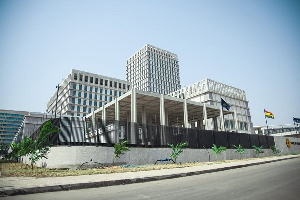Synopsis: This article seeks to focus on the development of a modern highway system in Ghana. The paper is intended to present highway system concepts, outline basic methods of numbering schemes, naming of highways, standardization and classification, and briefly describe their impact on national development. Basic approaches used numbering highway systems in developed countries is discussed. Examples examined include the German Autobahn, U.S Interstate highway system and UK Motorway. Features of the highway system numbering scheme is summarized.
Introduction
Until the advent of the motorcar around the turn of the 20th century and subsequently modern highway systems, most roadways were not numbered. This is still the case today in Ghana. Many ancient roads and trackways in Europe date back to the era of the Roman Empire. Italy was the first country in the world to develop a modern highway system, the Autostrada dei Laghi from Milan to Varese, in 1924.In the United Kingdom, roadways numbering scheme was first conceived in 1919. It was developed in Parliament as a method of simply identifying roads for internal government use, which includes standardizing rates of grants for road improvements according to the road's importance to traffic. Classification of roads allowed grants to be determined and fixed. Motorways in the UK use a zoning system approach based on 1–digit system, and the first motorway was opened in December 1958.
The U.S Interstate Highway system and U.S Highway system numbering scheme was developed in 1957 by the American Association of State Highway and Transportation Officials (AASHTO). The Interstate Highway numbering scheme was modeled on the German Autobahn. This idea was first brought into effect by U.S President, Dwight D. Eisenhower during the 1950's after his experience during a tour of Germany after the Second World War. The Interstate highway system is 1 or 2–digits numbering scheme, and are commonly known as I–XX, representing the assigned number. Some sections of the Interstate highways system are assigned 3–digit codes. These are typically used for a bypass, a radial or circumference loop in urban built-up areas.
The German Autobahn concept is based on the number system, the north–south reference and odd number identifier, and west–east reference and even number identifier. The Autobahn numbering scheme is a 1–digit system. The system is supplemented by 2–digit codes for regional routes and extends to 3–digit codes for local routes.
Exit numbering schemes vary in many countries. Two common exit numbering schemes are the sequential and distance–based numbers. The sequential type of exit numbers usually begins with Exit 1 at the beginning of the highway, and each subsequent exit is given the next number. Sometimes letter suffixes are added at multi-exit interchanges. In distance–based exit numbering, the distance from the beginning of the highway to the exit is used for the exit number.
Numbering Scheme of the Ghana Highway System
A roadway can be described as a line or vector. Consider the State Transport Bus network. At the network hub, all of the important major routes radiate from Accra going to different destinations. Major radial routes are summarized as follows: | Accra – Ho, Accra – Kumasi, Accra – Sunyani, Accra – Koforidua etc. |
The Ghana Highway system is modeled after the German Autobahn and U.S Interstate highway system. The primary objective is to link all the regional capitals and other major population centers with a modern highway system. The system also aims to promote inter-region trade through highway development and management of road network. In general, the highways system will be paved, wide to meet international standards, not have too sharp bends, have multiple lanes of traffic in each direction separated by a central barrier and have enough built-in capacity to avoid congestion and further expansion.
Numbering scheme for the Ghana Highway system is 1-digit, that is, each highway system is assigned one digit starting from 1 to 9. Odd numbers will run in North-South direction, while even numbers will run West-East. Arterial routes are given 2 and 3-digit codes, which represents regional and local roads, and prefixed with the letter A.
Understanding the Ghana Highways System
The Accra to Tema motorway was built in the early 1960's by the CPP administration. Plans to expand motorway construction were shelved when Dr. Kwame Nkrumah was over-thrown in 1966. Motorway improvement and construction were re-started in 1990's. The motorway M prefix convention used in many countries is used for the Ghana Highway system. The 1-digit numbering scheme indicates motorway, and represents major routes of national significance.
For 2 and 3-digit arterial routes prefixed A, the 2-digit routes roughly indicates an area within a given region, while 3-digit represents local areas. The North-South reference and West-East reference convention is maintained within each region.
List of Motorways
The motorway would follow existing roads wherever possible thereby preserving the investment in earlier highway works. The number of the motorway you’ll be driving on will give you a rough idea of where you are geographically in Ghana, and the direction of traffic flow. A list of motorways is summarized as follows:
M1 | Hamale – Lawra – Wa – Sawla – Bole – Bamboi – Wenchi – Techiman – Kumasi – Obuasi – Dunkwa – Tarkwa – Axim |
M2 | Newtown – Axim – Takoradi – Cape Coast – Salt Pont – Wineba – Accra – Denu/Aflao|
M3 | Navrongo – Bolgatanga – Wulugu – Tamale – Kintampo – Techiman – Kumasi – Bekwai – Cape Coast |
M4 | Sampa – Berekum – Sunyani – Bechem – Kumasi – Konongo – Nkawkaw – Koforidua – Accra – Ho |
M5 | Nakpanduri – Wulugu – Tamale – Salaga – Yeji – Atebubu – Ejura – Mampong – Kumasi – Konongo – Nkawkaw – Kade – Swedru – Winneba |
M6 | Sawla – Damongo – Tamale – Yendi – Zabzugu |
M7 | Bawku – Nakpanduri – Gshiago – Yendi – Dumbai – Kpando – Tema |
M8 | Hamale – Tumu – Navrongo – Bawku |
M9 | Wawjawga – Yendi – Bimbila – Hohoe – Ho – Dzodze – Denu/Aflao |
Notes to the Motorway Development: A ferry connecting motorway links for M5 at Yeji ferry terminal, M7 at Dumbai ferry terminal and a local Arterial route Kwadjokrom – Kete Krachi ferry terminal links can be replaced with a floating bridge. A floating bridge is essentially a pontoon anchored to either side of a river or lake, e.g. the I-90 and the Evergreen Point floating bridges across Lake Washington, WA, USA. It is feasible to construct floating bridges at the narrow points of the Volta Lake near to Yeji, Dumbai and Kwadjokrom – Kete Krachi ferry terminals.
Nomenclature of Arterial Routes
Below is a guide to the numbering scheme of the arterial routes. Knowing the number of the arterial route series will give you a rough idea of the local information in the region when you are driving.
Table 1. Arterial Routes
2-digit routes
A10 – A19
A20 – A29
A30 – A39
A40 – A49
A50 – A59
A60 – A69
A70 – A79
A80 – A89
A90 – A99
3-digit routes
A100 – A199
A200 – A299
A300 – A399
A400 – A499
A500 – A599
A600 – A699
A700 – A799
A800 – A899
A900 – A999
Related Region
: Volta : Greater Accra : Eastern : Central : Western : Ashanti : Brong-Ahafo : Northern : Upper West & East
Visualizing the Vision
Assume you live in a city, town or village in Ghana, and want to travel to visit a friend or family members who live in another city, town or village, or just want to get away from it all, to go out there, to explore other parts of the country. How would you get there? You could drive, if you have a car, or take a State Transport Corporation bus or a Private Transport bus in your area.In a typical scenario across Ghana, a numbered highway system would help you to organize and plan your trip efficiently. Imagine you’re driving on motorway Mx and changed somewhere onto Axx and later changed to Axxx in the local area. You could obtain info about your trip using your in-car navigation gadget, or online @ www.ghanamotorwayquest.com. Okay, I made up that one for fun. It was just an idea, but then, ideas are the fuel for progress, they say.
In today’s global competitive economy, a high-speed highway system infrastructure is desirable. As early as the 1960's, Dr. Kwame Nkrumah identified the need for the country to construct motorways. Although many now recognize how important this initiative was, several decades of political instability derailed some of his development projects. Today, as the country's population continues to grow, the volume of traffic on the roads is increasing. This increased traffic density is contributing to longer travel times and more accidents. Mass transit systems alone cannot combat the congestion in urban areas.
The vision for the future is to develop and implement a transportation system that will provide inter-regional movement of people and freight. The highway system concept outlined can help accomplish this goal, and it would help the nation’s transportation system work more efficiently. The highway system offers many benefits, including: • Creating jobs and facilitating economic growth • Providing civil engineers with information they can use to improve the transportation system
Its impact on the economy is incalculable. The numerous jobs it would produce in construction – roads, bridges, tunnels if they meet highway system standards, opening up rural areas and beyond, would eventually change the face of Ghana.
Beyond Numbers and Codes
The highway system concept outlined offers a framework to develop a modern national transportation system. Planning and design engineers at the Ghana Highways Authority can use the concept outlined to develop computer models of the highway system.
In practically all modem highways engineering, detailed civil engineering soils analysis of a proposed highway alignment is a crucial part of a highway design process. Results of soils analysis are used to develop design details of cut sections such as depth and slope of the cut. The use of satellite imagery for establishing road horizontal alignments is now common in high-speed highway design. Adding to that, inexpensive digital road maps and high-resolution satellite imagery data are now available for various applications.
In highway works, the road itself is the end result and the purpose of the design, therefore models of a highway is important when selecting surfacing materials and scheduling routine maintenance projects. The engineer has to keep in mind that, the perception of the driver of the highway features ahead is an important human factor that can considerably affect traffic safety, hence should be addressed in highway system design. It goes without saying that an erroneous perception of the highway can lead to actions that may compromise traffic safety.
Finally, from the viewpoint of national development goals, if the concept outlined is implemented, it will be building on Dr. Kwame Nkrumah’s vision recognizing the motorway's importance to the nation's growth and development.
About the Author Roger Numetu is a civil engineering graduate of the Michigan Technological University where he received Ph.D. degree in Civil Engineering with specialization in Remote Sensing and Geospatial Analysis. His research interests include remote sensing, digital image processing and GIS applications. In his free time, he writes about development issues in Ghana. Contact email: rnumetu@mtu.edu
References * This article does not cite any references or sources. The Ghana Highway System concept was inspired by the German Autobahn and the U.S Interstate Highway system, and was created by the author.














